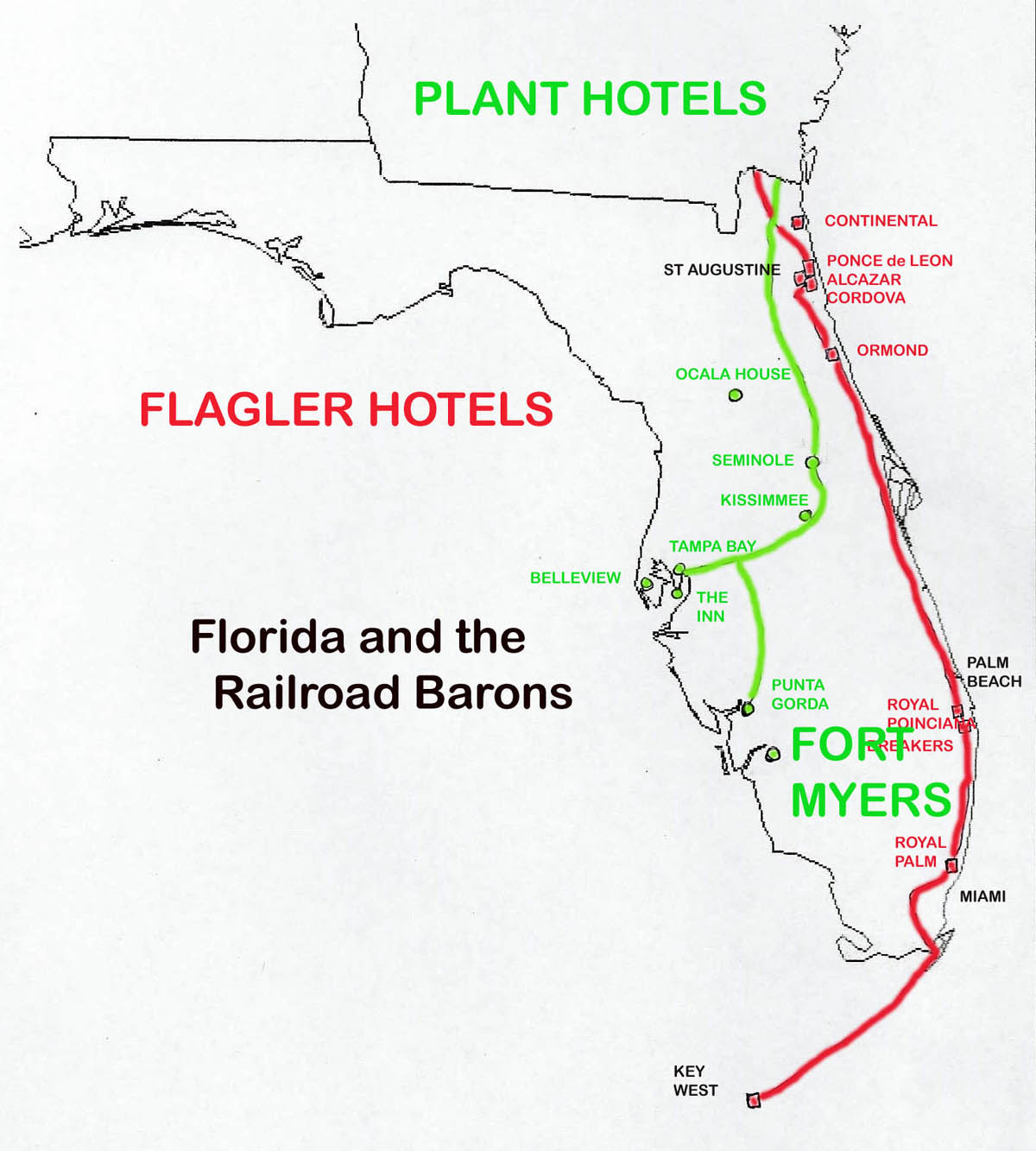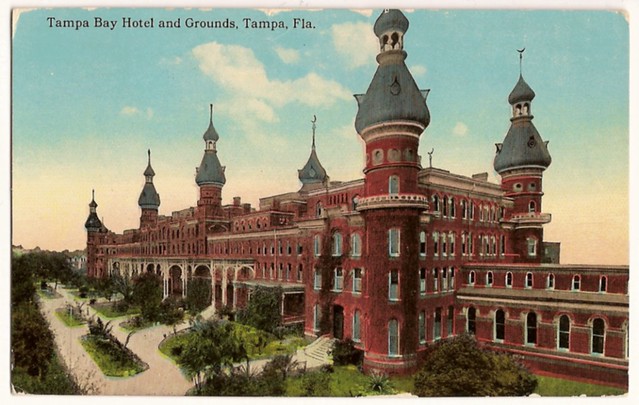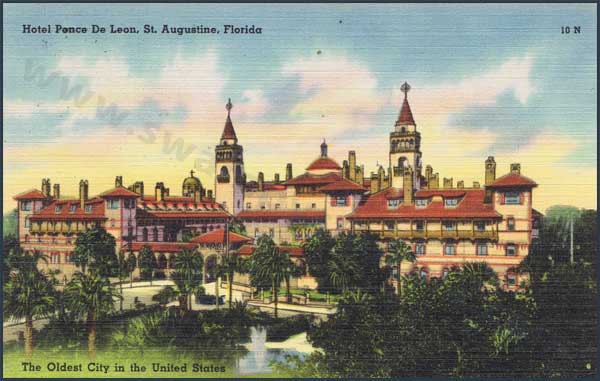
FLORIDA
OF THE RAILROAD BARONS
POLITICAL CHANGE AND ECONOMIC GROWTH IN FLORIDA 1880-1900
THE POLITICS OF LAND
Just as the Louisiana Purchase opened the West to settlers in 1803, the Disston Purchase
of 1881 cleared the way for a mass development of South Florida, a
development that would seriously reshape Florida's
political and economic future.
Thirty
years earlier the State of Florida purchased
from the Federal Government's Swamp and Submerged Lands
program millions of acres of land for public sale and railroad construction.
The Florida
Internal Improvement Fund held title to this land, but during the Civil War era
its trustees found few customers except land speculators. Most payments were
made in worthless Confederate script, rendering the entire system about a
million dollars in debt and tied up in legal battles.
The
largest creditor of the state debt was
Francis Vose who tied up the land in court
until the state found the money to pay off its debts. The Bourbon Democrats,
mostly planters and businessmen, did not want to spend tax moneys on this debt,
but Florida
needed to clear the debt to expand. Investment in the least populated state
east of the Mississippi was stymied, but
Governor Bloxham found a white knight to rescue the
state in Philadelphia
saw manufacturer HAMILTON DISSTON .


 River Landing At Jacksonville
River Landing At Jacksonville
Disston recognized
the tremendous potential of Florida real
estate south of Gainesville and agreed in 1881
to purchase four million acres of "listed swamp and submerged lands",
from the Kissimmee Basin to the Everglades, with large sections along
the Gulf Coast, at just twenty-five cents an
acre. Most of the land was suitable for some form of successful agriculture.


Tallahassee businessmen cheered their Northern savior
and the ending of debts without increased tax burden. Disston
was no generous patron; he realized the potential wealth of much of his
purchase. He was also no friend to the hundreds of farmers who tilled in the Kissimmee Valley under the Armed Occupation Act of
1842. The Swamp Act superseded their homestead titles and they only had to pray
Disston did not demand payment for their isolated
farms.
Disston's canal
company immediately dredged large sections of fertile muck lands out of the Kissimmee marshes.
Overnight new agricultural regions opened up.
In the Pinellas Peninsula,
Disston started a town on the bayou of Lake Butler,
invited rich Northern to build winter homes, and made the birth of Tarpon
Springs. Disston City, today near the town of
Gulfport, was opened in 1884 as the beginning of that region's farm growth.
The
intrusion of Disston's huge dredges in the Caloosahatchee Valley was a warning to the cattlemen
that the days of the homesteaders were beginning. In the winter of 1884-85
hundreds of Northern visitors arrived in the region including Thomas Alva Edison who decided to
bring a prefab winter complete, complete with South Florida's first swimming
pool, to Fort Myers. The father of the electric bulb and the phonograph
attracted dozens of other winter residents including Henry Ford.
Before the
railroad steamboats controlled the destiny of much of Florida. If you did not live along the coast
or along a navigable river, you were living in isolation. The fur trappers and
Seminoles, cowboys and fishermen ruled the frontier, but not for long.
THE RAILROAD BARONS OF FLORIDA
The Disston Purchase stimulated the interest
in railroad builder, for the State of Florida could offer land deals to
railroad development much like the transcontinental railroad system growing in
the West.
The
greatest development was due to three major railroad barons: William D. Chipley in the Panhandle; Henry B. Plant on the Gulf of Mexico;
and Henry F. Flagler on the
Atlantic Coast. Their domain contained more than just railroad track - they
built hotels, roads, and villages. Their track gave birth to new towns and
small trunk railroad developments.
WILLIAM D. CHIPLEY, the son of a Georgia Baptist preacher,
became the most important developer of the growth of West Florida, an area of
lumbering and farming interests. Chipley had a knack of buying up bankrupted
railroads and turning them into profitable enterprises, by improving the
rolling stock and developing a shipping system that saved farmers money. In
1874, he received a charter to construct the Pensacola
and Atlantic Railroad across West Florida to Apalachicola.
The Panhandle was dependent upon river transportation which only flowed
southward until Chipley spanned the rivers and connected the Panhandle to
northbound railroads in East Florida.
Chipley's
railroad promoted large scale development of the Panhandle's lumber and farming
assets. It was, however, not until 1906 when developer George M. West started the Gulf Coast Development Company on St. Andrews Bay that coastal urban centers
developed. West named his fishing port Panama City since it was halfway between Chicago and Panama. The railroad turned the
steamboat towns into fishing villages.

THE WEST
COAST
Further down the West Coast, a Connecticut
businessman Henry
Bradley Plant started the railroad boom when he obtained a charter
for a South Florida Railroad from
Sanford on the St. Johns River to Tampa Bay.
Plant's railroad turned Tampa into a deep water
center for freighters and steamers from Cuba
and South America. The rail line opened up the
region to citrus and vegetable growers for it no longer took twenty days to
reach Northern markets by boat.
 With two years Henry Plant's railroad had
attracted the Key West cigar industry and
Northern manufacturers to Tampa,
as well as a host of investors who started trolley lines and electric
companies. Nothing was as spectacular as Henry Plant's largest hotel, the Tampa Bay Hotel, on the Hillsborough River
in downtown Tampa.
At one hundred dollars per day, Plant hoped to attracted
the Northern rich to his empire. Plant's railroad ended Cedar Key's reign as a
passenger terminal.
With two years Henry Plant's railroad had
attracted the Key West cigar industry and
Northern manufacturers to Tampa,
as well as a host of investors who started trolley lines and electric
companies. Nothing was as spectacular as Henry Plant's largest hotel, the Tampa Bay Hotel, on the Hillsborough River
in downtown Tampa.
At one hundred dollars per day, Plant hoped to attracted
the Northern rich to his empire. Plant's railroad ended Cedar Key's reign as a
passenger terminal.


In 1885,
the Orange Belt Railroad of Sanford
was sold to an ambitious Russian refugee named Peter A. Demens. With a Disston grant, Demens built a
railroad down the Pinellas peninsula, fostering such towns as Dunedin,
Clearwater, and Largo. General John WIlliams,
pioneer of St. Petersburg and former Detroit Mayor, wanted the port town named
for his home city, but in a coin flip, the town was baned
for Demen's Russian home St. Petersburg. Demens dreamed of a
commercial port, but when the American Medical Society in 1885 named St. Petersburg "The Health City",
Demen's city became a retirement and resort
community.

THE ATLANTIC
COAST
HENRY MORRISON FLAGLER was the most ambitious of the railroad
barons since his empire eventually stretched from Northeast Florida to Key West. The son of a
poor New York
minister, Flagler lived a Horatio Alger story by rising from country clerk to
bookkeeper and business partner of John D. Rockerfeller.
He came to Florida in 1879 due to the
deteriorating health of his first wife, and was recruited by Florida's business community to consider a
new career.
In 1885 he
purchased the small Jacksonville to St. Augustine
to Halifax Railroad and started thirty
hour Pullman service to New York City.
The idea immediately made St. Augustine a
winter destination to railroad tours. He built three hotels in St. Augustine, but the
death of his first wife and remarriage convinced him to continue southward.

 In 1893, he selected a small, sandy island
called Palm City and built a huge hotel called "The Breakers" to promote
his railroad growth. When the railroad reached Palm Beach,
affluent Northerners were already planning their winter mansions. Flagler built
his new wife a massive marble winter mansion called Whitehall and Palm Beach soon became the winter watering hole of America's
industrial elite. Flagler topped even this with the 1,500 room Royal Poinciana Hotel, the largest
wooden hotel in the world. Now, Henry Plant's Biltmore in Pinellas County
is the largest.
In 1893, he selected a small, sandy island
called Palm City and built a huge hotel called "The Breakers" to promote
his railroad growth. When the railroad reached Palm Beach,
affluent Northerners were already planning their winter mansions. Flagler built
his new wife a massive marble winter mansion called Whitehall and Palm Beach soon became the winter watering hole of America's
industrial elite. Flagler topped even this with the 1,500 room Royal Poinciana Hotel, the largest
wooden hotel in the world. Now, Henry Plant's Biltmore in Pinellas County
is the largest.
Flagler
originally planned to retire in Palm Beach, but the freeze of 1894-95 convinced
him that lands further south than Indian River would one day yield America's
winter crops. Near old Fort Dallas on the Miami River
lived Mrs
Julia D. Tuttle who sent Flagler a blossoming orange branch in the midst
of the freeze. With Plant extending his domain down the Gulf
Coast, Flagler took the challenge to
continue his railroad to Biscayne Bay.
Hundreds
of settlers sailed ahead to Lemon City, the only developed port in Biscayne
Bay. In 1896, when Flagler's train reached the Miami area, some 3,000 new residents were
waiting. Miami did not attractive the elite of Palm Beach, but began to grow as
a tourist center. Flagler wanted to control the Miami waterfront,
but found the pioneers wanted a bay front park.


In 1912
Flagler was still following his dream when he gained funding for one of the
great engineering feats in American history - the construction of a railroad to
the island of Key West. Ninety-one miles of road and
thirty-eight bridges allowed Flagler's trains to reach Key West. Unfortunately, the Hurricane of
1935 would destroy Flagler's amazing Overseas
Railroad.
RAILROADS AND INDUSTRY IN GILDED ERA FLORIDA
The railroads were necessary in the rapid transportation of bulk goods
and agricultural products that had to reach Northern markets in a few days
after harvesting. The railroad network bolstered an old Florida industry: the sugar industry. Hamilton Disston himself
started the successful Florida Sugar Manufacturing Company in the Clewiston area.
Flagler's railroad allowed for sugar production along Lake
Okeechobee.
A more
unusual development was popularized by one Albertus Vogt, who became famous when his African-American helper tied his
fishing boat to the remains of a fossilized bone and Vogt realized that Florida
was rich in high grade phosphate in both the upper Peace River Valley and
around Dunnellon.
 Vogt became known as the "Duke of Dunnellon", a
millionaire when his fields were active and broke when he his investment went
dry. He owned thousands of acres and promoted at least four phosphate booms.
Once when low on cash, but high on land, he even buried leaking oil cans on his
property to sell the useless land to speculators. Phosphate mining provided a
reliable product for shipment by railroad or boat along the Gulf Coast.
Vogt became known as the "Duke of Dunnellon", a
millionaire when his fields were active and broke when he his investment went
dry. He owned thousands of acres and promoted at least four phosphate booms.
Once when low on cash, but high on land, he even buried leaking oil cans on his
property to sell the useless land to speculators. Phosphate mining provided a
reliable product for shipment by railroad or boat along the Gulf Coast.


At a time when young African Americans were leaving the Deep South in record
numbers to seek opportunity in the factories of Northern cities, the growth of
railroads and other industries in Florida were attracting African Americans
from Panhandle Florida, Georgia, and Alabama into Southern
Florida. A majority of the phosphate miners were black. Most of
the laborers on the large hotels were black. It was necessary to establish
residential communities for all the African Americans who serviced the growing
number of resorts and projects. New urban black villages grew up along the Florida East Coast.
AGRICULTURAL BOOM
The belief that Florida
land was too sandy or marshy for profitable development had been a common
concern in the Deep South for generations. The Florida
railroaders showed the entire world the bountiful crops that South
Florida could produce. Since South Florida land sold for a
fraction of Northern land and less than most farm land in the Deep South, the
homesteaders flooded down the rail lines into Florida in the late nineteenth
and early twentieth centuries.

People
across the farm belts of the United
States were heard sprouting the railroad
promotion slogans, "Below the frost line" and "ten acres and
independence". At the turn of the century one thousand dollars gave you a
nice piece of Florida
acreage and a cottage. Such an investment could yield $3,400 in tomatoes in one
year. Despite the need for huge doses of fertilizer and heavy labor, Southern
farmers considered Florida
an agricultural paradise.
The cattle kingdom would never be the land
of open range and long trail drives, but the development of scientific cattle
breeding had arrived by 1900. Prior to experimentation, ninety per cent of Florida's herds were
ill-fed, unattended beef herds. The resultant beef products were mainly for
local consumption. Natal hay from South Africa and the introduction
of foreign livestock like the Indian Brahman began to change the cattle
industry.
OVERVIEW
In 1876 Florida was a backward
agricultural state with poor transportation connections to the North and Midwest. By 1900, the foundation of the state's growth had
been forecast with the construction of railroad systems along both coasts into Southern Florida. The railroad baron had started the
winter hotel resort industry at a scale that the early steamboat companies
along the St. Johns River could not imagine.
Despite these changes, the mind and spirit of Florida society was not ready for too many
changes.







 With two years Henry Plant's railroad had
attracted the
With two years Henry Plant's railroad had
attracted the 






